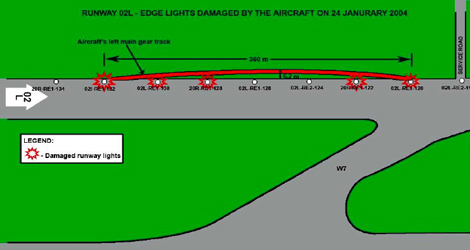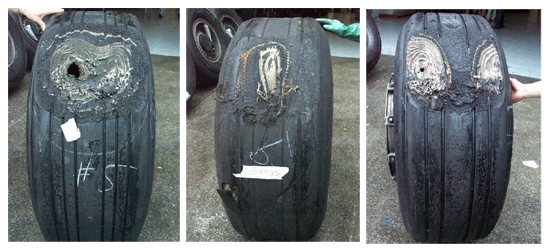Singapore Airlines flight SIA236 was a scheduled service from Brisbane, Australia to Singapore operated with a Boeing B777-200. The flight was normal until the landing at 2035 hours at the Singapore Changi Airport.
The first officer (FO) was the pilot flying (PF) the aircraft.
The weather information broadcast by ATIS ‘O’ at 1930 hours was rain over the airfield with braking action on Runway 02L reported as medium, wind calm and visibility of 6 km. This was updated by another ATIS ‘P’ at 2006 hours and the changes were highlighted by the Pilot-in-Command (PIC) to the PF during the descent.
The crew intended to land with an autobrake setting of 3 and the use of full reverse thrust on a wet runway was also discussed. During the descent both pilots were concerned about the weather and commented on the weather radar showing ‘all red’ (clouds with high water content). The crew obtained a deviation to avoid the weather.
On initial contact with Changi control tower, the crew of Singapore Airlines flight SIA236 were advised of rain over the airfield and strong low level windshear.
The crew were also advised of medium to poor braking action reported by a preceding arrival aircraft.
At about 1,800 ft, Changi control tower advised the flight to continue its approach and that there was strong crosswind, but no windshear reported by the preceding arrival aircraft. At this point, the PF indicated that he would conduct an automatic landing (autoland).
The PIC concurred, saying that they ‘might as well do an autoland’ as they ‘would not be able to see the runway until a few hundred feet’.
Shortly after, a landing clearance was given by the tower with the surface wind reported at 140 degrees and 15 knots.
When the PF sighted the runway about 45 seconds later (about 600 ft above ground level) he requested to land the aircraft manually instead of using the autoland. The PIC agreed with the PF’s request. The PF disengaged the autopilot at about 520 ft.

ground path of Singapore Airlines flight SIA236 – Boeing B777-200 (9V-SRG)
In order to counter the crosswind, and maintain the desired ground track, the autopilot was maintaining a crab angle of 5 degrees into the wind. The aircraft’s heading was 28 degrees and the ground track was 23 degrees.
After the autopilot was disengaged, the PF used the cross control technique, of applying left rudder while lowering the right wing, to counter the crosswind. The aircraft maintained the glideslope at a descent rate of about 750 ft per minute with an indicated airspeed of about 135 knots. The Vref was about 128 knots.
In response to changing wind conditions, the PF made frequent aileron and rudder adjustments to maintain the aircraft on the localizer of the Instrument Landing System (ILS).
At about 200 ft above ground, the aircraft started to deviate to the right of the localizer with the right wing low. At about 150 ft above ground, the aircraft was indicating 0.1 dot to the right of the localizer while the right wing went lower to about 2 degrees.
During descent from 100 to 38 ft, the PF further applied corrective actions to return the aircraft to the localizer. At about 80 ft, the right wing low became a left wing low of more than 3 degrees.
The aircraft moved from 0.1 dot on the right of the localizer at 26 ft to 0.1 dot left of the localizer at about 10 ft with the left wing remaining low at 2.85 degrees.
At one second before touchdown, the aircraft pitch attitude was 1.2 degrees nose up. At touchdown, the aircraft pitched nose up at 1.4 degrees, whereas the normal nose pitch should be about 2.5 degrees.
Singapore Airlines flight SIA236 landed firm at 1.6 g at 0.1 dot to the left of the localizer which is about 4 m to the left of runway centreline at an indicated airspeed of 131 knots (ground speed of 148 knots) with the left wing low at 1.1 degrees.
According to the crew the aircraft skidded to the left on touchdown.
The left hand landing gear of the aircraft departed the runway for about six seconds. From the wheel tracks in the soft ground, it was determined that the left hand landing gear had rolled about 360 m on the grass verge with the maximum displacement of about 6.2m from the runway edge
DFDR data showed the landing gear “Not Tilt” indication (indicating that the aircraft had touched down) for about four seconds. After that, the “Not Tilt” indication was changed to a “Not Valid” indication.
The PIC took over the control of the aircraft with full right rudder application and brought the aircraft back on the paved surface of the runway.
Some antiskid system fault messages appeared on the EICAS (Engine Indication and Crew Alerting System) display during the excursion. These messages were most likely the result of damage sustained on the left hand landing gear after it departed from the paved runway surface.
The PIC taxied the aircraft to the assigned passenger gate after assessing it was safe to do so. The persons on board disembarked normally from the aircraft through the aerobridge.
- The aircraft was airworthy and there were no pre-existing system deficiencies that could have contributed to the incident.
- The crew was properly qualified and rested to operate the flight.
- The continuously changing wind conditions near touchdown made it difficult for the PF to make accurate adjustments to land the aircraft on the centreline with the correct flare. Consequently the aircraft landed about 4 m to the left of the centreline of Runway 02L and touched down firm at 1.6 g with the left wing low.
- The wet runway, rain, and changing wind conditions contributed to the skidding and reverted rubber aquaplaning experienced by the aircraft, which resulted in it leaving the paved surface of the runway.
- The transverse slopes of Runway 02L, the runway shoulders and the runway strips (adjacent grass verge) of Changi Airport meet the relevant recommendations of the Singapore Manual of Aerodrome Standards and ICAO SARPs for water drainage.
- The crew were aware of the changing weather conditions over the airfield. With the complications of strong crosswind and rain over the airfield, landing the aircraft with the autopilot could have lessened the workload of the crew and allowed them more time to monitor the approach and landing.
- The aircraft was not adequately maintained on the desired ground track and aircraft attitude, owing to the changing wind conditions at low altitude.
- Though the transverse slopes of Runway 02L have been constructed in accordance with the requirements stipulated in the Singapore Manual of Aerodrome Standards, rain water did not drain away fast enough from the shoulders of the runway.
Download Report


Excellent. Good experience for the FO, but when things past the point of a valid learning experience, the Captain took over, as I have had to do on occasion during my career. The trick is: recognizing that moment when you’re at the point that the FO is beyond his/her ability and yet the situation is still within yours.
Singapore airlines dhaka office is in Gulshan-2.
One of the largest airlines in the world is Singapore Airlines. The International Air Transport Association (IATA) gives airlines like SQ two-character codes.
Changi Airport in Singapore is the main place where things happen. The three-letter code for the airport is SIN. The business began on May 1, 1947. KrisFlyer is a program for people who go a lot.
The main hub of Singapore Airlines is in Singapore. From there, the airline flies to 64 destinations in 32 countries on six continents. Singapore Airlines ordered the world’s largest passenger plane, the Airbus A380, first.